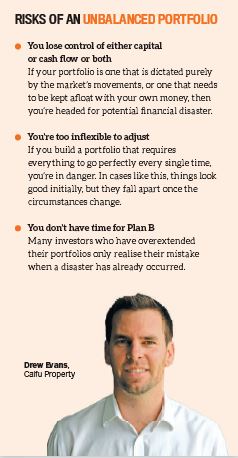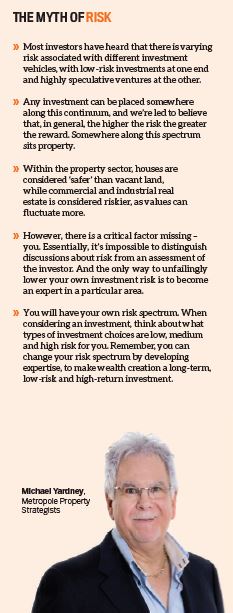Property, like any investment, comes with risk. Some successful investors step into the market at just the right time, and they are able to make a killing off massive-growth properties in the right areas.
However, there are no ‘sure win’ properties you can rely on to always make money. With ever-evolving cycles and property markets, things can change in the blink of an eye, and many investors fall when they buy indiscriminately in the hope of snagging that magic property – ultimately straining their finances.
“An unbalanced portfolio is one where you don’t have direct control over your capital or your cash flow – or, worse still, both,” explains Drew Evans of Caifu Property.
“You lose control of your capital when you are 100% reliant on the market movements to give you all of your capital growth. You lose control of your cash flow when your portfolio requires input from your salary to maintain itself.” Balanced or diversified portfolios are carefully curated and built to last even if a once-thriving market should plummet, minimising loss and generating equity to allow you to fund more investments.
Diversifying can take many forms. For instance, you can invest across different states, cushioning your portfolio should market trends shift suddenly in one city but not another. You can also amass a mix of houses and apartments, depending on where lifestyle trends in a particular suburb are going.
“The key to balancing a portfolio is to create a portfolio that pays you, and you never pay for it,” Evans says.
Here are some tips for creating that balance in your portfolio without breaking your bank.

Before you start investing, you need to take a sober look at where you are financially, because this information tells you how far you can go with your portfolio.
“The bank looks at your borrowing capacity, which is your capacity to service a loan, and at your capacity to put down a deposit,” says Philippe Brach, CEO of Multifocus Properties and Finance. “The first thing an investor has to do is balance out these two elements.”
It’s crucial that in determining your ceiling you don’t factor in all of your savings. Leave some reserve money as security for yourself.
“You want to keep a buffer – it is going to be useful for RISKS OF AN UNBALANCED PORTFOLIO interest rates that may go up, unexpected repairs and maintenance,” Brach says.
To invest affordably and within your financial limits, this could mean backing out of a market you’ve been eyeing that is too expensive for you. However, that doesn’t mean you’re out of options; there could be a neighbouring location available at more reasonable prices.
Priced out of major capital cities? Consider looking into regional pockets that are gaining some traction.
2.Go for diversity
If you’re looking to capitalise on different growing markets, make sure they’re not the same types of markets. For example, investors who tried to get in on the mining boom in Queensland and WA learned the hard way when the mining downturn caused investments in both of these areas to go south.
“You want to buy property in different locations with very different economies so that you’re spreading your risk,” Brach says.
“Make sure that these properties are within commutable distance from a capital city. That’s what’s going to make your property grow, when people want to live where you are – where the engine of the Australian economy is.”
“An unbalanced portfolio is one where you don’t have direct control over your capital or your cash flow – or, worse still, both”
3. Research growth prospects
Property is not the kind of investment that generates instant cash; it requires patience. Therefore, it’s important to look not just at whether a location or a type of property sells now, but at whether it will be worth something several years from now.
“Residential real estate is a high-growth, relatively low-yield investment. Real wealth is achieved through long-term capital appreciation and the ability to refinance to buy further properties,” explains Michael Yardney, CEO of Metropole Property Strategists.
The property cycle is one thing you should keep your eye on, as it will tell you how much value you can get out of a certain location, as well as when it is best to hold or to sell. Look also at population growth rates, lending criteria, infrastructure projects in the pipeline, and how well supported the economy is.

Even if you’re mainly looking for investments for long-term growth, it’s wise to have positive cash flow properties in your portfolio to keep the money rolling in and give you an additional buffer should growth prospects change.
“Never create a property portfolio that requires you to have a job to sustain it. If you are tipping in money each week, or you are dependent on tax deductions for cash flow, your portfolio is exposed,” Evans says.
“The day your employment changes, your portfolio can’t sustain itself and it is overextended. In a flat market, you are locked into working at your job because you can’t sell down your portfolio and realise profits to eliminate some of your debt.”
“Real wealth is achieved through long-term capital appreciation and the ability to refi nance to buy further properties”
Take a close look at rental yield statistics when you’re buying. There are properties and locations that will offer growth prospects while also generating short-term passive income.
For every hugely successful investor, there are many more struggling landlords who often don’t make it past their first investment. Ultimately, property investment is a strategy game, and you need to plan effectively to get the most out of it. Aim to be in it for the long haul, which means you should avoid gambling everything on a potential investment. Do the research, invest within your means, aim for a strong cash flow scenario, and keep focused on long-term targets.
If you follow these steps, you’ll be in the best possible position for property success.